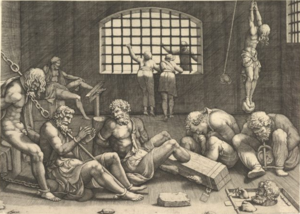- v50 information can now be added to pages in the main namespace. v0.47 information can still be found in the DF2014 namespace. See here for more details on the new versioning policy.
- Use this page to report any issues related to the migration.
Restraint
v50.12 · v0.47.05 This article is about the current version of DF.Note that some content may still need to be updated. |
|
| ||||||
| Construction | ||||||
|---|---|---|---|---|---|---|
| Materials | Workshops | Labors | ||||
| Rooms | ||||||
Restraints can be built from chains or ropes, using the keys b + r + h. They can be used to tie up guard non-pet animals, prisoners, criminals or livestock. Also of note is that after you do tie up a individual they are not shown as such if you decide to tie up another at another chain/rope. Currently as of 50.05 they are not listed with the chained up icon. It's recommended as a workaround to rename the animal with chained in the name. So "War Dog" can be renamed "Chained War Dog" and will be listed as "Stray Chained War Dog"(Game automatically puts the Stray if the animal does not have a name). They are listed with a chain icon in the list when assigning animals to a pasture so this is probably just a quirk of the UI.
A restraint is (technically) a 1-tile large building, a chain or rope which is used to restrain a dog, dwarf or other creature to a certain very limited area of movement. Unlike a cage, a restraint can only hold one creature, and the creature can move within a range of one tile from the location of the restraint itself, including up and down if stairs or slopes are in this area. This gives them, at most, a 3×3×3 cube of movement, limited as normal by walls, doors etc. Restraints do not block movement, including movement of wagons. While an animal is assigned to it the same as with a cage, dwarves can and will only be assigned from within the justice system inside a dungeon zone.
Restraints can be used to keep a war dog or other animal near areas where you need constant vigilance and defense. Chained animals placed near the entrance to your fort will spot kobold thieves that can bypass traps and other passive defenses, pausing the game and announcing their presence. A pair of animals, placed opposite each other against the walls of a 3-wide corridor (so they cannot have more than 1 tile between them), are guaranteed to spot any thief that tries to enter, and (if combative) will similarly engage any hostile creature. But assigning a pasture for the guard animal is more resource efficient way to guard specific areas. This also allows the animal to walk away on its own if there ever is an alert that forces everybody to a certain area.
Restraints can also be useful in the meat industry, since animals on restraints can breed, unlike animals in cages. Chained animals are also available for training (when the appropriate zone has been designated around the chain). This can be particularly important for dangerous creatures that are only partially tame. Dwarves will also feed animals on restraints if they get hungry, making them an effective way to keep grazing animals alive during sieges.
Restraints are also very useful in weaponizing otherwise untrainable creatures that you've managed to capture in a cage trap. Hostile creatures on restraints will no longer be aggressive to dwarves, which means semi-megabeasts, megabeasts, and even forgotten beasts can be chained up where a guard is needed as these will still draw aggression from invaders and undead, and will fight back when possible (within range of being restrained). Beware though, as forgotten beasts with special attacks like deadly dust may still use it liberally even if chained, and this can be harmful to dwarves. Restrained building destroyers may destroy nearby buildings, so they should be located a safe distance from anything destructible (including other restraints).
Currently, due to a bug, a restrained animal will keep the restraint on their upper body if it's deconstructed while the animal is still restrained. This can be used to "equip" your beasts with decorations, such as spiked chain collars or lavish ropes, but has no in-game effect. Similarly, if you move a caged were-creature in its non-were form to a chain, and then de-assign it that chain, it will immediately recage itself rather then be set free. Its unclear if the cage is duplicated when this happens or if the prisoner has the cage as an item.
If a creature falls down from a ledge while restrained, it will not be left hanging. Instead, it will be released from the restraint and keep falling.
Bugs
Trivia
- Restrained creatures may like the quality of the rope or chain they are restrained by and receive a boost in happiness, despite their imprisoned position.
| Furniture | |
|---|---|
| Tools | |
| Access | |
| Constructions | |
| Machine and trap parts |
Axle • Gear assembly • Lever • Mechanism • Millstone • Pipe section • Pressure plate • Roller • Screw pump • Support • Trap • Water wheel • Windmill |
| Other buildings | |
| Related articles | |
